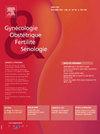[乳腺癌:我们能否将其视为职业暴露疾病?]
IF 0.6
4区 医学
Q4 OBSTETRICS & GYNECOLOGY
引用次数: 0
摘要
目的:乳腺癌是女性发病率和死亡率最高的癌症。目前的文献指出了几种风险因素,其中有些可以改变,有些则不能。由于乳腺癌具有多因素性,各种因素的综合作用会增加或减少患癌风险。自 2004 年以来,法国国家环境健康计划第一委员会的报告已认识到职业暴露对乳腺癌发病的重大影响。然而,无论是一级还是二级预防措施都尚未在工作环境中实施:方法:根据现有文献,我们回顾了与职业暴露相关的乳腺癌风险因素的现有知识:结果:确定的风险因素包括电离辐射、磁场、某些内分泌干扰物、环氧乙烷和夜班工作:结论:将乳腺癌认定为职业病非常复杂。然而,在某些情况下,特别是在接触多种因素的情况下,将乳腺癌认定为职业病是可能的。这项工作应有助于提高雇主的认识,加强工作场所的预防措施。本文章由计算机程序翻译,如有差异,请以英文原文为准。
Cancer du sein : peut-on l’envisager comme une maladie professionnelle ?
Objective
Breast cancer is the leading cancer in women in terms of incidence and mortality. The literature currently identifies several risk factors, some modifiable and others not. Because of its multifactorial nature, the combination of factors either increases or reduces the risk of cancer. Since 2004, the first commission's rapport of the French National Environmental Health Plan has recognized the significant impact of occupational exposure on the development of breast cancer. However, neither primary nor secondary preventive measures have yet been implemented in work environment.
Method
Based on available literature, we reviewed current knowledge of breast cancer risk factors associated with occupational exposure.
Results
The risk factors identified were ionizing radiation, magnetic fields, certain endocrine disruptors, ethylene oxide and night shift work.
Conclusion
Recognition of breast cancer as an occupational disease is complicated. In some cases, however, it may be possible, particularly in cases of multifactorial exposure. This work should help to raise awareness among employers and reinforce preventive measures in the workplace.
求助全文
通过发布文献求助,成功后即可免费获取论文全文。
去求助
来源期刊

Gynecologie Obstetrique Fertilite & Senologie
Medicine-Obstetrics and Gynecology
CiteScore
1.70
自引率
0.00%
发文量
170
期刊介绍:
Gynécologie Obstétrique Fertilité & Sénologie est un mensuel scientifique d''information et de formation destiné aux gynécologues, aux obstétriciens, aux sénologues et aux biologistes de la reproduction. La revue, dans ses éditoriaux, articles originaux, mises au point, lettres à la rédaction et autres rubriques, donne une information actualisée ayant trait à l''obstétrique et à la gynécologie et aux différentes spécialités développées à partir de ces deux pôles : médecine de la reproduction, médecine maternelle et fœtale, périnatalité, endocrinologie, chirurgie gynécologique, cancérologie pelvienne, sénologie, sexualité, psychosomatique…
 求助内容:
求助内容: 应助结果提醒方式:
应助结果提醒方式:


